
Crataegus laevigata, known as the Midland hawthorn, English hawthorn, woodland hawthorn, or mayflower, is a species of hawthorn native to western and central Europe, from Great Britain and Spain, east to Romania and Ukraine. The species name is sometimes spelt C. levigata, but the original orthography is C. lævigata.

Celtis laevigata is a medium-sized tree native to North America. Common names include sugarberry, southern hackberry, or in the southern U.S. sugar hackberry or just hackberry.
Hymenostegia bakeriana is a species of plant in the family Fabaceae. It is found in Cameroon and Nigeria. It is threatened by habitat loss.

Prosopis laevigata, commonly known as smooth mesquite, is a species of flowering tree in the pea family, Fabaceae, that is native to Mexico, Bolivia, Peru, and north-western Argentina. In Mexico, the species is found in the nation's the central highlands, the lowlands of southern Tamaulipas, and in parts of Oaxaca, Morelos, Puebla, and Chiapas. It grows on a variety of sites on hillslides, in depressions, and along floodplains. It has been spotted growing in the Middle East as well.
Napoleonaea lutea is a species of woody plant in the family Lecythidaceae. It is found only in Nigeria. It is threatened by habitat loss.

Gaudium laevigatum, commonly known as the coast tea tree, is a species of shrub or small tree that is endemic to south-eastern Australia, but has been widely introduced in other places where it is often considered to be a weed. It has thin, rough bark on the older stems, narrow egg-shaped leaves, relatively large white flowers and flat topped fruit that is shed shortly after reaching maturity.

Haliotis laevigata, common name the smooth Australian abalone or greenlip abalone or whitened ear shell, is a species of sea snail, a marine gastropod mollusk in the family Haliotidae, the abalone.
Aegiphila cordifolia is a species of flowering plant in the family Lamiaceae. It is endemic to Peru, where it occurs in the Amazon rainforest. It is sometimes found in disturbed habitat.
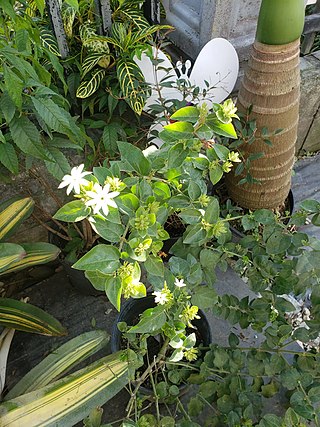
Buxus citrifolia is a species of plant in the family Buxaceae. It is found in Colombia, Panama, and Venezuela. This interesting shrub has not been known to occur in Central America, having only been collected and/or reported in Cuba, Puerto Rico, and Venezuela. Buxus citrifolia is nearly extinct and has been on the endangered list.
Grossera elongata is a species of plant in the family Euphorbiaceae. It is endemic to Príncipe.
Homalium smythei is a species of flowering plant in the family Salicaceae. It is found in Ivory Coast, Guinea, Liberia, and Sierra Leone. It is threatened by habitat loss.
Pavetta mollissima is a species of plant in the family Rubiaceae. It is found in Ghana and possibly Ivory Coast. It is threatened by habitat loss.
Monoon hypogaeum is a species of plants in the custard apple family Annonaceae. It is a tree endemic to Peninsular Malaysia.
Pseudoxandra is a genus of plant in family Annonaceae. It contains the following species:
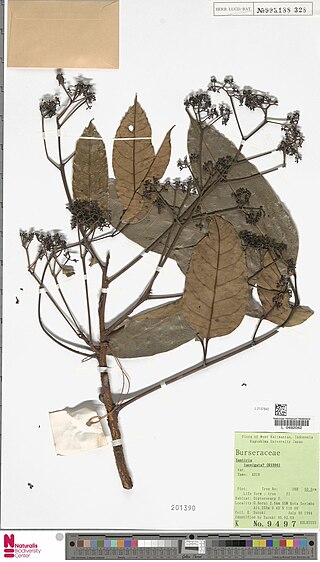
Santiria laevigata is a species of plant in the Burseraceae family. It is found in Indonesia, Malaysia, the Philippines, and Singapore.
Microsynodontis laevigata is a species of upside-down catfish endemic to Gabon where it is found in the Ivindo River. It was first described in 2004 by Ng Heok Hee.
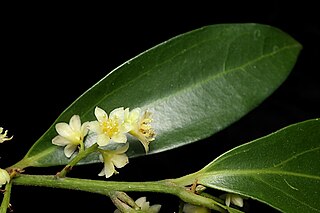
Cryptocarya laevigata, commonly known as red-fruited laurel, glossy laurel or grey sassafras, is a species of flowering plant in the family Lauraceae and is native to Malesia, New Guinea and eastern Australia. It is a shrub or tree with lance-shaped to elliptic leaves, creamy white, pale green and perfumed flowers, and more or less spherical, red to orange-yellow drupes.
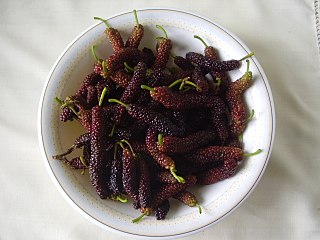
Morus macroura, also known as the king white mulberry, shahtoot mulberry, Tibetan mulberry, or long mulberry is a flowering plant species in the genus Morus found in Tibet, the Himalayas, mountainous area of Indonesia, and rain forests of Indochina. It is a medium-sized tree, with a spreading canopy which grows with a weeping habit. Ripe fruit is white, pink or red, and is described as honey-sweet.

Pseudoxandra polyphleba is a species of plant in the family Annonaceae. It is native to Bolivia, Brazil, Colombia, French Guiana, Guyana, and Peru. Ludwig Diels, the German botanist who first formally described the species using the basionym Unonopsis polyphleba, named it after the distinctive veins in its leaves.
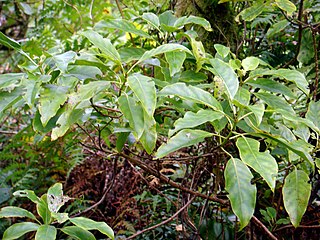
Coprosma laevigata, the Rarotongan coprosma, is a herbaceous plant, a member of the Rubiaceae family.











